Toledo, Spain
| Toledo | |||
|---|---|---|---|
| — City — | |||
 |
|||
|
|||
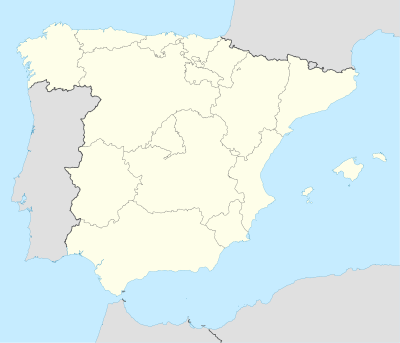 Toledo
|
|||
| Coordinates: | |||
| Country | |||
| Autonomous Community | |||
| Province | Toledo | ||
| Comarca | Toledo | ||
| Partido judicial | Toledo | ||
| Settled | ca. 7th Century B.C. | ||
| Government | |||
| - Mayor | Emiliano García-Page Sánchez (PSOE) | ||
| Area | |||
| - Land | 232.1 km2 (89.6 sq mi) | ||
| Elevation | 529 m (1,736 ft) | ||
| Population (2008)INE | |||
| - Total | 80,810 | ||
| Postcode | 45001-45009 | ||
| Area code(s) | +34 | ||
| Twin Cities | |||
| - Toledo | USA | ||
| - Nara | Japan | ||
| - Agen | France | ||
| - Safed | Israel | ||
| - Veliko Tarnovo | Bulgaria | ||
| - Aachen | Germany | ||
| - Corpus Christi | USA | ||
| Website | http://www.ayto-toledo.org/ | ||
Toledo (Latin: Toletum, Arabic 'طليطلة Ṭulayṭulah)) is a municipality located in central Spain, 70 km south of Madrid. It is the capital of the province of Toledo. It is also the capital of autonomous community of Castile-La Mancha. It was declared a World Heritage Site by UNESCO in 1986 for its extensive cultural and monumental heritage as one of the former capitals of the Spanish Empire and place of coexistence of Christian, Jewish and Moorish cultures. Many famous people and artists were born or lived in Toledo, including Al-Zarqali, Garcilaso de la Vega, Eleanor of Toledo, Alfonso X and El Greco. It was also the place of important historic events such as the Visigothic Councils of Toledo. As of 2007[update], the city has a population of 78,618 and an area of 232.1 km2 (89.59 square miles).
Contents |
History
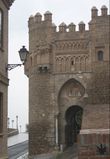
Having been populated since the Bronze Age, Toledo (Toletum in Latin) grew in importance during Roman times, being a main commercial and administrative center in the Roman province of Tarraconensis. After the fall of the Roman Empire, Toledo served as the capital city of Visigothic Spain, beginning with Liuvigild (Leovigild), and was the capital of Spain until the Moors conquered Iberia in the 8th century.
Under the Caliphate of Cordoba, Toledo enjoyed a golden age; it became a very large cosmopolitan city with an overwhelming Muladi population. This extensive period is known as La Convivencia, i.e. the co-existence of Jews, Christians, and Muslims. Under Arab rule, Toledo was called Tulaytulah (Arabic طليطلة, academically transliterated Ṭulayṭulah). After the fall of the Caliphate, Toledo was the capital city of one of the richest Taifa Muslim kingdoms of Al-Andalus, and, because of its central location in the Iberian Peninsula, Toledo took a central position in the struggles between the Muslim and Christian rulers of northern Spain. The conquest of Toledo by Alfonso VI of Castile marked the first time a major city in Al-Andalus had fallen to Christian forces; it served to sharpen the relegious aspect of the Christian reconquest.

On May 25, 1085, Alfonso VI of Castile took Toledo and established direct personal control over the Moorish city from which he had been exacting tribute, ending the medieval Taifa's Kingdom of Toledo. This was the first concrete step taken by the combined kingdom of Leon-Castile in the Reconquista by Christian forces. After Castilian conquest, Toledo continued to be a major cultural centre; its Arab libraries were not pillaged, and a tag-team translation centre was established in which books in Arabic would be translated from Arabic or Hebrew to Spanish by Arab and Jewish scholars, and from Spanish to Latin by Castilian scholars, thus letting long-lost knowledge spread through Christian Europe again. For some time during the 16th century, Toledo served as the capital city of Castile, and the city flourished. However, soon enough the Spanish court was moved, first to Valladolid and then to Madrid, thus letting the city's importance dwindle until the late 20th century, when it became the capital of the autonomous community of Castile-La Mancha. Nevertheless, the economic decline of the city helped to preserve its cultural and architectural heritage. Today, because of this rich heritage, Toledo is one of Spain's foremost cities, receiving thousands of visitors yearly.
| Historical populations | ||
|---|---|---|
| Year | Pop. | %± |
| 1991 | 59,000 | — |
| 1996 | 66,006 | 11.9% |
| 2001 | 68,382 | 3.6% |
| 2004 | 73,485 | 7.5% |
| 2006 | 77,601 | 5.6% |
Toledo's Alcázar (Arabicized Latin word for palace-castle) became renowned in the 19th and 20th centuries as a military academy. At the outbreak of the Spanish Civil War in 1936 its garrison was famously besieged by Republican forces.
Economy
The metal-working industry has historically been Toledo's economic base, with a great tradition in the manufacture of swords and knives and a significant production of razor blades, medical devices and electrical products. Soap and toothpaste manufacture, flour milling, glass and ceramics have also been important.[1]
According to the Statistical Institute of Castilla-La Mancha, in 2007 the distribution of employment by sectors of occupation was as follows: 86.5% of the population engaged in the services, 6.6% in construction, 5.4% in industry and 1.5% in agriculture and livestock.[2]

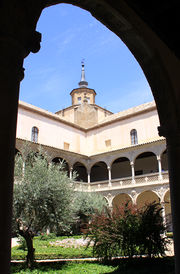
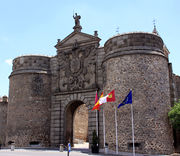
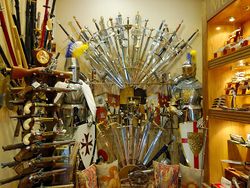
The manufacture of swords in the city of Toledo goes back to Roman times, but it was under Moorish rule and during the Reconquista that Toledo and its guild of sword-makers played a key role. Between the 15th and 17th centuries the Toledo sword-making industry enjoyed a great boom, to the point where its products came to be regarded as the best in Europe. Swords and daggers were made by individual craftsmen, although the sword-makers guild oversaw their quality. In the late 17th and early 18th century production began to decline, prompting the creation of the Royal Arms Factory in 1761 by order of King Carlos III. The Royal Factory brought together all the sword-makers guilds of the city and it was located in the former mint. In 1777, recognizing the need to expand the space, Carlos III commissioned the architect Sabatini to construct a new building on the outskirts of the city. This was the beginning of several phases of expansion. Its importance was such that it eventually developed into a city within the city of Toledo.
In the 20th century, the production of knives and swords for the army was reduced to cavalry weapons only, and after the Spanish Civil War, to the supply of swords to the officers and NCOs of the various military units. Following the closure of the factory in the 1980s, the building was renovated to house the campus of the Technological University of Castilla-La Mancha in Toledo.[3]
Unemployment
In the last decade, unemployment in absolute terms has remained fairly stable in the city of Toledo, but in 2009 this figure increased significantly: nearly 62% compared to 2008, with the number of unemployed rising from 2,515 to 4,074 (figures at 31 March each year), according to the Junta de Comunidades de Castilla La Mancha.[4] Of this 62%, one third of the increase took place in the first quarter of 2009, with 3,385 unemployed in December 2008 rising to 4,074 in March 2009.
By gender men are more affected (2,065 unemployed) than women (2,009), while the age group most affected is between 25 and 29 years of age, with 708 unemployed.
From the standpoint of the professional activity of the unemployed, the vast majority of registered unemployed in the city of Toledo, with 72% of the total, were in the services sector, corroborating the importance of the tertiary sector in the city's economy. Distribution of unemployed by sector (31 March 2009) Sector Agriculture and fisheries Industry Construction Services No previous job Unemployed 59 (1.45%) 352 (8.64%) 588 (14.43%) 2,937 (72.09%) 138 (3.39%)
According to other statistics from the same source, almost half the unemployed in the city of Toledo (1,970 persons) are among those in whose education does not go beyond the compulsory secondary level. However, there are groups whose level of studies is such that they have not been registered as unemployed, such as those who have completed class 1 professional training, or those with virtually non-existent unemployment rates (less than 0.1%), which is the case of unemployed with high school degrees or professional expertise.
The largest group amongst the unemployed is that of those who have no qualifications (27.27%).
Politics
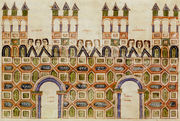
Culture
The old city is located on a mountaintop with a 150 degree view, surrounded on three sides by a bend in the Tagus River, and contains many historical sites, including the Alcázar, the cathedral (the primate church of Spain), and the Zocodover, a central market place.
From the 4th century to the 16th century about thirty synods were held at Toledo. The earliest, directed against Priscillian, assembled in 400. At the synod of 589 the Visigothic King Reccared declared his conversion from Arianism; the synod of 633 decreed uniformity of liturgy throughout the Visigothic kingdom and took stringent measures against baptized Jews who had relapsed into their former faith. The council of 681 assured to the archbishop of Toledo the primacy of Spain. At Guadamur, very close to Toledo, was dug in 1858 the Treasure of Guarrazar, the best example of Visigothic art in Spain.
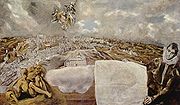
As nearly one hundred early canons of Toledo found a place in the Decretum Gratiani, they exerted an important influence on the development of ecclesiastical law. The synod of 1565–1566 concerned itself with the execution of the decrees of the Council of Trent; and the last council held at Toledo, 1582–1583, was guided in detail by Philip II.
Toledo was famed for religious tolerance and had large communities of Muslims and Jews until they were expelled from Spain in 1492 (Jews) and 1502 (Muslims). Today's city contains the religious monuments the Synagogue of Santa María la Blanca, the Synagogue of El Transito, Mosque of Cristo de la Luz and the church of San Sebastián dating from before the expulsion, still maintained in good condition. Among Ladino-speaking Sephardi Jews, in their various diasporas, the family name Toledano is still prevalent—indicating an ancestry traced back to this city (the name is also attested among non-Jews in various Spanish-speaking countries).
In the 13th century, Toledo was a major cultural center under the guidance of Alfonso X, called "El Sabio" ("the Wise") for his love of learning. The program of translations, begun under Archbishop Raymond of Toledo, continued to bring vast stores of knowledge to Europe by rendering great academic and philosophical works in Arabic into Latin. The Palacio de Galiana, built in the Mudéjar style, is one of the monuments that remain from that period.
The Cathedral of Toledo (Catedral de Toledo) was built between 1226–1493 and modeled after the Bourges Cathedral, though it also combines some characteristics of the Mudejar style. It is remarkable for its incorporation of light and features the Baroque altar called El Transparente, several stories high, with fantastic figures of stucco, paintings, bronze castings, and multiple colors of marble, a masterpiece of medieval mixed media by Narciso Tomé topped by the daily effect for just a few minutes of a shaft of light from which this feature of the cathedral derives its name. Two notable bridges secured access to Toledo across the Tajo, the Puente de Alcántara and the later built Puente de San Martín.
The Monasterio de San Juan de los Reyes is a Franciscan monastery, built 1477-1504, in a remarkable combination of Gothic-Spanish-Flemish style with Mudéjar ornamentation.
Toledo was home to El Greco for the latter part of his life, and is the subject of some of his most famous paintings, including The Burial of the Count of Orgaz, exhibited in the Church of Santo Tomé.
Toledo was famed for its production of iron and especially of swords and the city is still a center for the manufacture of knives and other steel implements.
When Philip II moved the royal court from Toledo to Madrid in 1561, the old city went into a slow decline from which it never recovered.
Gastronomy
The marzipan of Toledo is considered one of its finest food products.
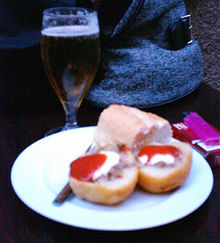
Toledo's cuisine is the cuisine Castilla-rooted in its traditions and is closely linked to hunting and grazing. A good number of recipes are the result of the combination of Moorish and Christian influences.
Among his specialties include the lamb roast or stew, as cuchifrito, and beans with partridge or stewed partridge, the carcamusas, the crumbs, the porridge Mancha and the tortilla to the lean. Two of the foods that have brought fame to the city of Toledo are the Manchego cheese and marzipan, which has a denomination of origin itself, the marzipan of Toledo. [40] [41]
Holidays
- Virgen del Valle: This pilgrimage is celebrated on May 1 at the Ermita de la Virgen del Valle, with a concentration popular holiday in that place.
- Easter: Declared of National Tourist Interest, is held in spring with various processions, highlighting those that take place on Good Friday, and religious and cultural events. Since the Civil War, most of the steps were burned or destroyed, so it had to create new steps or using images from other churches and convents Toledo. Being a city Toledo Castile, Holy Week is characterized as austere and introspective, as well as beauty, due in part to the beautiful framework in which it takes place: Toledo. Many people take advantage of the Easter break to visit the monastery churches that are only open to the general public at this time of year. [42]
- Corpus Christi: Feast declared International Tourist Interest. Its origins lie in the thirteenth century and is probably the most beautiful Corpus Christi there. The processional cortege travels around two kilometers of streets and richly decorated awnings. In recent years, following the transfer of the traditional holiday Thursday present Sunday, was chosen to conduct two processions, one each of these days, with certain differences in members and protocol between them. [43]
- Virgen del Sagrario: On August 15 they celebrate the festival in honor of the Virgen del Sagrario. Procession is held inside the Cathedral and drinking water of the Virgin in jars.
Apart from these festivals should be noted that patterns of Toledo are:
- San Ildefonso, Toledo Visigoth bishop whose feast day is January 23.
- Santa Leocadia, virgin and martyr of Roman Hispania, which falls on December 9.
Main sights
| Historic City of Toledo* | |
|---|---|
| UNESCO World Heritage Site | |
|
Old city of Toledo |
|
| State Party | |
| Type | Cultural |
| Criteria | i, ii, iii, iv |
| Reference | 379 |
| Region** | Europe |
| Inscription history | |
| Inscription | 1986 (10th Session) |
| * Name as inscribed on World Heritage List. ** Region as classified by UNESCO. |
|
The city of Toledo was declared a Historic-Artistic Site in 1940, UNESCO later given the title of World Heritage in 1987. Sights include:
- Castillo de San Servando. Medieval castle near the banks of the Tagus river and the Infantry Academy.
- The Gothic Cathedral, dating from the thirteenth century. Inside there is the Clear from Narciso Tome, in Baroque.
- Monasterio de San Juan de los Reyes, in Elizabethan Gothic style (15th century)
- The Renaissance Museo-Hospital de Santa Cruz (16th century)
- Museo de El Greco. House-museum designed as a recreation of the artist's home, which was lost centuries ago. It houses several important paintings.
- Santa Maria la Blanca, the oldest synagogue building in Europe still standing, now owned by the Catholic Church
- Synagogue de el Transito, in the neighborhood Jew. It is home to the Sephardic Museum.
- Hospital de Tavera Museum Duque de Lerma. Renaissance style, dates from the sixteenth century. Influenced the layout of El Escorial.
- Church of Santiago del Arrabal, inMudejar style.
- Iglesia de Santo Tome. Mudejar style, the fourteenth century, houses the famous Burial of Count Orgaz, by El Greco.
- El Cristo de la Luz, a small mosque-oratory built in 999, later extended with Mudejar apse for conversion into a church.
- Galiana Palace (13th century), in Mudejar style.
- Tornerías Mosque (11th century)
- Alcazar fortress (16th century), located in the highest part of town, overlooking the city. From 2009 it houses the collection of the Army Museum.
- Puerta del Sol. Mudejar style and built by the Knights Hospitallers in the fourteenth century.
- New Gate of Hinge, by Alonso de Covarrubias (16th century, based on Arabic structures)
- Old door hinge or Puerta de Alfonso VI
- Puerta del Cambron, of Muslim-16th century origin
- San Román (Museum of the Councils and Visigoth culture)
- Ermita del Cristo de la Vega, in Mudejar style (11th century)
- Puente de Alcántara
To mark the fourth centenary of the publication of the first part of Don Quixote+, the Council of Communities of Castile-La Mancha designed a series of routes through the region crossing the various points in the novel are cited. Is known as the Route of Don Quixote and two of pathways designed, sections 1 and 8, are based in Toledo: those linking the city with La Mancha Castile and Montes de Toledo exploiting the natural route which passes through the Cigarrales and heads to Cobisa, Nambroca Burguillos of Toledo where he takes the Camino Real from Sevilla to suddenly turn towards Mascaraque Almonacid de Toledo, deep into their surroundings, near Mora, in La Mancha.
This stretch Mascaraque-Toledo of the Route of Don Quixote has recently been included in an official way on the Camino de Santiago in Levantine branch with origins in Cartagena, Alicante and Valencia, as both routes share declared European Cultural Route route on this stretch .
Infrastructure
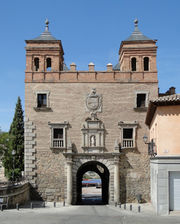
Toledo has since long been obligatory step in the center of the peninsula. The roads leading to historic Toledo are still used and in many cases have provided the basis to existing roads leading into the city.
Roads
From Toledo part of N-400, which links this city with Cuenca by Ocaña and Tarancón. It is currently in the process of transformation in the future A-40 motorway Castilla La Mancha, which will link Maqueda (where it joins the motorway Extremadura), Toledo, Ocaña (where it attaches to the Motorway of Andalusia), Tarancón (where connects with the motorway Levante), Cuenca and Teruel.
The old National Road 401 Madrid-Toledo-Ciudad Real was transformed in the late 80s in the current A-42 as a result of splitting and deleting the path that the various crossings counted (Illescas, Yuncos, etc.. ).
The split path can take 7 km south of Toledo, in effect Ciudad Real, where it continues as conventional road. At this point, the A-42 connects with the Highway of the Vineyard that reaches Tomelloso. It is planned to extend the A-42, by a toll road, to Ciudad Real and Jaén.
In the early twenty-first century was built, in order to decongest the access of Madrid, the toll motorway AP-41.
Another way of State Highway Network that Toledo is part of the N-403, Toledo-Maqueda - Ávila - Adanero. Part of the route of this road will be replaced by that of the aforementioned Highway of Castilla La Mancha.
In addition to these roads, from Toledo depart several regional and provincial-level linking the capital with the regions of Montes de Toledo, La Jara and La Mancha.
Rail
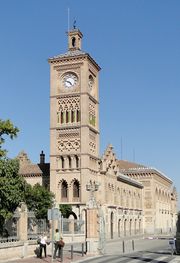
In the mid-nineteenth century Toledo was one of the first Spanish cities that had rail, being attached to Madrid Aranjuez line and being opened by Elizabeth II on June 12 of 1858. The current station style neomudéjar, was inaugurated on April 24 of 1919 and is a remarkably beautiful building, especially the paneling in the main hall of the same.
With several ups and downs in terms of technical equipment and services this is the line that served until the early twenty-first century: on July 2 of 2003 the last train runs between the two capitals conventional and begin work on the link high-speed, Madrid - Toledo, entering service on November 16 of 2005, thanks to which the travel time to Madrid has been reduced to just under 30 minutes.
Health
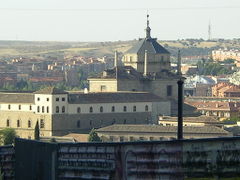
In the early 60s of the twentieth century began the construction of the Residence Health Social Security "Virgen de la Salud". The original building still remains in use, although successive extensions were added (maternity, outpatient clinics, operating rooms, etc.). Into the existing complex. The complex was also extended to move the clinic to a new nearby building, now converted into Specialty Center San Ildefonso.
On October 6 of 1974 inaugurated the National Hospital of Paraplegics who becomes the center of reference, both nationally and internationally, in the treatment of these lesions. Also carries out a major work of social integration of their patients.
The transfer of powers from the state health at the Junta de Comunidades de Castilla La Mancha will give new impetus to the health infrastructure, manifested in 2007 with the commencement of construction of the new General Hospital of Toledo in the Santa Mary Benquerencia. Also have been provided to the different parts of the relevant health centers.
In the Toledo Hospital Complex [36] is also integrated Geriatric Hospital Virgen del Valle, a result of reform and modernization of old tuberculosis hospital built in the mid twentieth century. The center is located outside the city, near the Parador Nacional de Turismo Conde de Orgaz.
With regard to private health, at present the city of Toledo has several centers: Hospital de las Tres Culturas, Clínica Nuestra Señora del Rosario, and so on.
Sport
The city of Toledo suffered from a shortage of sports facilities. Much of this problem was resolved when the Central School of Physical Education of Army moved its headquarters to the premises of the Academy of Infantry. In the 90s, the city council took over the old facilities (39 ° 52'10 "N 4 ° 1'42" W / 39.86944, -4.02833) of the military center, which include in Today: an athletics track, Olympic swimming pool and an indoor sports hall, from the former military installations, and numerous outdoor courts built in the area of the former runway of application, having been demolished and the old gym complex pools (indoor and outdoor).
Besides these facilities, the city of Toledo has covered sports pavilion in the districts of Santa Maria de Benquerencia, Santa Barbara, San Anton (Complejo Deportivo "Leaping Horse"); outdoor pools in sugar, Palomarejos, Santa Maria de Benquerencia, Santa Barbara, Santa Teresa and indoor swimming pools in the gardens of the Alcazar (old town), St. Mary of Benquerencia and St. Anton.
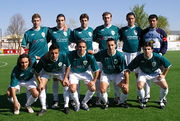
Toledo has a soccer team, the Club Deportivo Toledo, which returns in 2009-2010 to the Second Division B, after 7 Third season. The club plays its matches in the municipal field Leaping Horse, opened in 1973. The team he played for 7 seasons in second division and reached the promotion play with Real Valladolid for promotion to First Division in 1993/94, but was defeated on aggregate 4-1. They have been part of the player and Abel Resino, Luis Garcia, Rufete or Casquero.
Toledo also has teams of handball. The Toledo Handball, after 5 years in the Division de Honor B, start the 2009-2010 season as ASOBAL new club for the first time in its history. A refurbished town hall "Javier Lozano Cid ', with capacity for around 1,500 spectators, is its new headquarters. Moreover, the city has two other Division II team in the National, the Toledo Handball Lábaro-B and Club Deportivo Amibal. [37]
Toledo has two basketball teams: the CIS Toledo, with a long history that has gone through ups and downs in both regional and in national leagues (EBA) and has just promoted to 1st Autonomic, and CB polygon [38], in Currently the most representative, whose team has promoted male, 7 years after leaving, to EBA League to start the 09/10 season. This club based in the Santa Maria de Benquerencua has one of the largest quarries of Castilla-La Mancha.
Another sport representative of the Imperial City is athletics. This striking sport has since 2 April 1979 with the Toledo Athletic Club, [39] that is characterized by its actions, mainly in cross-country, where he managed a large number of medals in the championships team Spain's specialty, in addition to their combined male and female military in the late 90s in the 1st division league national track. Among the athletes who have passed through its lanes are great athletes as Julio Rey, Roberto Parra, Chema Martinez and Julia Lobato.
Cycling, meanwhile, after the mythical victory in the Tour de France in 1959 by Federico Bahamontes, 'The Eagle of Toledo', has been one of the sports with more followers in the city, although, at present, no school despite having a velodrome in the Santa Maria de Benquerencia. Other leading professional cyclists in the city have been Nemesio Jiménez (Mexico Olympic 68) and Angel de las Heras.
The FS and Volleyball Toledo Toledo Association Toledo complete representation in the National League of First and Second Division, after a brief journey in Fantasy-, respectively, while the Toledo Rugby Club, with many noisy fans, is immersed in the League Madrid's Primera Liga.
At the individual level, the swimmer Javier Noriega and Julio Rey marathon athletes are more representative of the city, both in Athens Olympics 2004 and Beijing 2008, in recent years. Rey, Spanish current marathon record holder, with 2h.06: 52, announced his retirement in October 2009.
Toledo Other sports are famous footballers Roberto Fresnedoso, Miguel Angel Ruiz, Luis Laguna, Pedro Pablo Braojos (now coach) and Luis Garcia, the latter serving goalkeeper on the CD Tenerife, and the indoor football players international Javier Lorente-champion Antonio Adeva Europe and World champion, not forgetting the former Spain coach Javier Lozano Cid world champion.
In handball, highlighted in the goalkeepers 09.10 ASOBAL Fermin Ballesteros (Toledo Handball Lábaro) and Gonzalo Perez-Vargas (FC Barcelona).
Media
In the city are published various local and provincial newspapers. In addition, national newspapers such as the ABC daily published an extensive local branch. Among the highlights local newspaper La Tribuna de Toledo, Toledo Day and free Global Castilla la Mancha and Toledo News. Weekly magazines are published for general information Echoes and here.
There are also local media in television, radio and Internet. In Toledo is the headquarters of regional public television, Castilla-La Mancha TV, plus there are six local television stations in addition to domestic routes: Localia, Diocesan Channel TV-Popular, Teletoledo, Regional Channel News and Tribune Television.
For radio stations, is the dean Radio Toledo (Onda Cero), the COPE, the Cadena SER, RNE, RCM and Radio here, other radios are the neighborhood Onda Polygon and the diocesan Radio Santa Maria. Within the digital and social media, Wave Toledo, Toledo Magic, Toledo Digital, La Cerca.
Gallery
 Alcázar of Toledo and Cathedral over the Tagus River |
A view across the river of the old wall of Toledo — August 2006 |
Zocodover square in Toledo. |
 Bridge of Alcántara |
International relations
Twin towns — Sister cities
 Agen, France, since June 22, 1973[5]
Agen, France, since June 22, 1973[5] Aachen, Germany, since October 13, 1984[5]
Aachen, Germany, since October 13, 1984[5] Corpus Christi, United States, since September 5, 1989[5]
Corpus Christi, United States, since September 5, 1989[5] Damascus, Syria, since April 19, 1994[5]
Damascus, Syria, since April 19, 1994[5]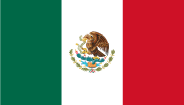 Guanajuato, Mexico, since October 20, 1978[5]
Guanajuato, Mexico, since October 20, 1978[5]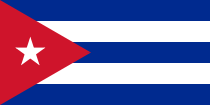 Havana, Cuba, since 2006[5]
Havana, Cuba, since 2006[5] Nara, Japan, since September 11, 1972[5]
Nara, Japan, since September 11, 1972[5] Safed, Israel, since September 8, 1981[5]
Safed, Israel, since September 8, 1981[5] Toledo, United States, since 1931[5]
Toledo, United States, since 1931[5] Veliko Tarnovo, Bulgaria, March 25, 1983[5]
Veliko Tarnovo, Bulgaria, March 25, 1983[5]
See also
- Spain
- Iberian Peninsula
- Golden age of Jewish culture in the Iberian Peninsula
- Palacio de Galiana
- Kingdom of Toledo
References
- This article incorporates text from the public domain Dictionary of Greek and Roman Geography by William Smith (1856).
Notes
- ↑ "Economía de Toledo". http://www.grupoteresa.com/modules.php?name=Guia_Turistica&file=pueblos&id=112&page=3. Retrieved 9 July 2008.
- ↑ "Instituto de Estadística de Castilla-La Mancha — Ficha municipal". http://www.ies.jccm.es/Fichas_municipales/Fichas/45168.pdf. Retrieved 21 July 2008.
- ↑ "lacerca.com - Las espadas forjadas en Toledo se remontan a la época romana". http://www.lacerca.com/noticias/las_espadas_forjadas_toledo_se_remontan_epoca_romana-21888-1.html. Retrieved 15 July 2008.
- ↑ "Instituto de Estadística de la Junta de Comunidades de Castilla-La Mancha - Datos estadísticos de Toledo (Todos los Informes > Informes por Temas > Estadísticas Municipales > Mercado de Trabajo)". http://difusion.ies.jccm.es/wds/ReportFolders/ReportFolders.aspx. Retrieved 5 April 2009.
- ↑ 5.00 5.01 5.02 5.03 5.04 5.05 5.06 5.07 5.08 5.09 5.10 "Sister Cities". Toledo Turismo. Patronato Municipal de Turismo. http://www.toledo-turismo.com/turismo/contenido/mas-toledo/toledo-historia/ciudades-hermanadas.aspx. Retrieved 2008-10-16.
External links
- Municipality
- Exhibit on Toledo, Ohio Sister City Agreement
- Photography of Toledo by Antony Marsh
- http://historiadefermosa.com "La Historia de Fermosa" Abraham S. Marrache, Hebraica Ediciones 2009, a historical novel in Spanish about the love affair in 1179 between King Alfonso VIII of Castile and the young Toledan Jewess, Fermosa.
- Sunset in Toledo, Eretz Acheret Magazine
|
|||||||||||||||||||||||||||||||||

